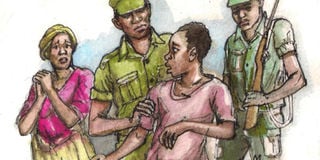puzzle, dies police custody

When death occurs of a person, changes must of necessity follow of the body. These changes also known as postmortem changes may be used to establish the time of death, circumstances of the death, the position in which the body was at the time of death and whether the position of the body was changed after death had occurred.
Immediately death occurs, a body goes limb and obeys the laws of gravity. It cannot do otherwise. And shortly after this, the body begins to stiffen. If the body is not moved, it will stiffen in the position dictated by gravitational forces. This stiffening wears off after 24 hours.
The heart also ceases to pump blood and the blood already in the various parts of the body will gradually pool, again, according to the laws of gravity resulting in distinct discoloration on the body. In places where the body is in contact with the surface it is lying on, there will be no such discoloration.
And so if a body is found to have stiffened in a position other than that dictated by gravity or the pooling of blood does not conform to the gravitational forces, it is then more than likely that the position of the body was tampered with after death had occurred.
The query
And so when a 23-year-old male adult was found hanging in a police cell and an inquest was ordered into this death, these postmortem changes were to prove critical in establishing the circumstances of the death. Two doctors were called to testify during the inquest.
The first doctor examined the body shortly after the deceased was alleged to have hanged himself. The police in their request for autopsy had clearly indicated that the young man had hanged himself. Indeed the doctor found a sleeve of a jacket knotted tightly around the neck of the deceased.
The deceased also had several injuries on the body.
The doctor, however, noted that the neck region was normal internally; that is, there was no bleeding into the neck muscles despite the tight ligature in the neck. And neither did the doctor observe any broken structures of the neck.
The doctor concluded that the young man had died as a result of hanging.
The doctor told court that he formed his opinion based on the information on the police request form and also the sleeve of jacket he found tightly around the neck of the deceased.
Asked whether he would have made same conclusion had the body been presented without the sleeve around the neck and the police suggesting the possible cause of death, the doctor confessed before the coroner that it would not have been possible to establish the cause of death.
Investigation gaps
The coroner found it strange that the doctor did not make comments on the injuries that he had documented so well on the body of the deceased. To the coroner these injuries should have been an eye-opener to the doctor to look for other causes of death other than suicide by hanging.
The coroner further faulted the doctor for not taking the trouble to examine the body to determine whether the body had features that are normally present in a case of suicide by hanging even when he told court that the body of a person who commits suicide by hanging normally had distinct features that can be easily seen.
The coroner said the doctor conducted his examination with the only aim of confirming what the police had stated in their request as the probable cause of death. This led the doctor to narrow down his examination to suit this position and he therefore, did not explore other possible causes of death.
To the coroner, the doctor’s report was not accurate and found to be very wanting in material terms and misleading and did not reflect a correct position of the cause of death of the inmate.
To be continued




